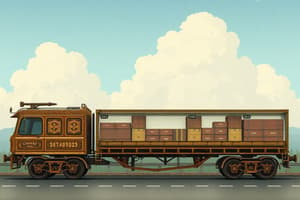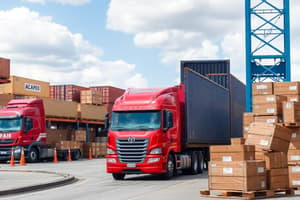Podcast
Questions and Answers
Which transportation modes might be chosen based on cost and speed?
Which transportation modes might be chosen based on cost and speed?
- Air (correct)
- Bicycle
- Ship (correct)
- All of the above
Information in a supply chain only refers to costs and prices.
Information in a supply chain only refers to costs and prices.
False (B)
What is the main factor that affects pricing decisions in a company?
What is the main factor that affects pricing decisions in a company?
Demand
The process used to purchase goods and services is known as ___ .
The process used to purchase goods and services is known as ___ .
Match the following sourcing activities with their descriptions:
Match the following sourcing activities with their descriptions:
Which metric tracks the typical size of incoming and outgoing shipments?
Which metric tracks the typical size of incoming and outgoing shipments?
What is the primary decision involved in sourcing regarding product production?
What is the primary decision involved in sourcing regarding product production?
Frequency of Update is the term for how far ahead predictions are made in demand forecasting.
Frequency of Update is the term for how far ahead predictions are made in demand forecasting.
Which of the following factors does NOT directly affect pricing?
Which of the following factors does NOT directly affect pricing?
Everyday Low Pricing involves varying prices over time to create demand spikes.
Everyday Low Pricing involves varying prices over time to create demand spikes.
What is a process flow diagram used for?
What is a process flow diagram used for?
The goal of pricing is to maximize __________ while meeting customer expectations.
The goal of pricing is to maximize __________ while meeting customer expectations.
Match the following pricing strategies to their descriptions:
Match the following pricing strategies to their descriptions:
What does the profit margin measure?
What does the profit margin measure?
What is the flow rate if demand is 8 units per hour?
What is the flow rate if demand is 8 units per hour?
A bottleneck in a process reduces overall capacity.
A bottleneck in a process reduces overall capacity.
In a process analysis, the flow units in a hospital could be defined as __________.
In a process analysis, the flow units in a hospital could be defined as __________.
Utilization is defined as the flow rate divided by capacity.
Utilization is defined as the flow rate divided by capacity.
What is implied utilization?
What is implied utilization?
If a resource's flow rate is 0.1333 units per minute and its capacity is 0.2 units per minute, the utilization is ___%.
If a resource's flow rate is 0.1333 units per minute and its capacity is 0.2 units per minute, the utilization is ___%.
Match the following resources with their utilizations:
Match the following resources with their utilizations:
Which resource has the highest utilization?
Which resource has the highest utilization?
In cases where demand is greater than supply, implied utilization will be 100% or less.
In cases where demand is greater than supply, implied utilization will be 100% or less.
How should a process analyze multiple types of flow units?
How should a process analyze multiple types of flow units?
What is the purpose of an employment verification agency in the described process?
What is the purpose of an employment verification agency in the described process?
A resource is considered a bottleneck if its implied utilization is below 100%.
A resource is considered a bottleneck if its implied utilization is below 100%.
What formula is used to calculate the available capacity for each resource?
What formula is used to calculate the available capacity for each resource?
The bottleneck is the resource with the highest ______ utilization.
The bottleneck is the resource with the highest ______ utilization.
Match the application types with their corresponding number of applications received per hour:
Match the application types with their corresponding number of applications received per hour:
What is the first step in identifying the bottleneck of the process?
What is the first step in identifying the bottleneck of the process?
If a resource has an available capacity of 12 applications per hour and a workload of 10 applications per hour, it is considered overloaded.
If a resource has an available capacity of 12 applications per hour and a workload of 10 applications per hour, it is considered overloaded.
What is the implied utilization for a resource with a workload of 20 applications per hour and an available capacity of 15 applications per hour?
What is the implied utilization for a resource with a workload of 20 applications per hour and an available capacity of 15 applications per hour?
Which product has the highest daily demand?
Which product has the highest daily demand?
Resource 3 is identified as the bottleneck in the process.
Resource 3 is identified as the bottleneck in the process.
What calculation is used to determine the capacity needed for Product A at each resource?
What calculation is used to determine the capacity needed for Product A at each resource?
Resource 3 can produce a maximum of ____ units of Product A per day.
Resource 3 can produce a maximum of ____ units of Product A per day.
Match the following products with their daily demand:
Match the following products with their daily demand:
What is implied utilization used for in this process?
What is implied utilization used for in this process?
What is the formula used to calculate available capacity for each resource?
What is the formula used to calculate available capacity for each resource?
To meet the demand of all products, Resource 1 is identified as the bottleneck.
To meet the demand of all products, Resource 1 is identified as the bottleneck.
Flashcards are hidden until you start studying
Study Notes
Supply Chain Management
- Supply chain management (SCM) involves managing the flow of goods and services from raw material suppliers to the end customer.
- Key Supply Chain Functions:
- Planning: Forecast demand, set production schedules, manage inventory levels.
- Sourcing: Select and negotiate with suppliers, manage contracts, ensure quality.
- Production: Produce goods efficiently, optimize production processes, manage equipment and labor.
- Delivery: Choose transportation methods, optimize routes, manage logistics, ensure timely delivery.
- Returns: Handle returns, manage reverse logistics, issue refunds or replacements.
Transportation in SCM
- Transportation Mode Selection: Consider cost, speed, and product type when choosing air, truck, rail, or other modes.
- Transportation Metrics:
- Average inbound/outbound transportation cost: Track the cost of moving goods in and out of facilities.
- Average shipment size: Assess the typical size of incoming and outgoing shipments.
Information in SCM
- Information's Role:
- Provides data and analysis for facilities, inventory, transportation, costs, prices, and customers.
- Connects different supply chain stages and enables coordination for profitability.
- Supports demand forecasting, inventory management, and supplier collaboration.
- Information Metrics:
- Forecast Horizon: Determines how far ahead predictions are made.
- Frequency of Update: Indicates how often forecasts are updated.
- Forecast Error: Measures the difference between predicted and actual demand.
- Seasonal Factors: Adjusts for demand changes during different seasons.
- Variance from Plan: Compares planned versus actual production or inventory levels.
Sourcing in SCM
- Sourcing Overview: Involves purchasing goods and services, includes supplier identification, evaluation, negotiation, contract management, and supplier relationship management.
- Key Sourcing Decisions:
- In-house or Outsource: Decide whether to manufacture in-house or outsource production.
- Supplier Selection: Determine the number of suppliers needed, set selection criteria, and choose suppliers through negotiation or auctions.
- Procurement: The process where the supplier delivers products based on customer orders.
Pricing in SCM
- Pricing's Impact:
- Influences demand, attracting different customers.
- Shapes customer expectations regarding quality and service.
- Balancing Supply and Demand:
- Adjusting prices can align product availability with customer demand.
- Discounts help sell surplus products.
- Pricing Factors:
- Cost Structure: Cost of producing and selling the product.
- Market Demand: How much customers want the product.
- Competition: Prices set by competitors.
- Economic Conditions: Inflation, economic growth, and customer purchasing power.
- Regulations: Government rules, taxes, and tariffs.
- Company Objectives: Goals like increasing market share, maximizing profits, or brand positioning.
- Pricing Strategies:
- Economies of Scale: Lower prices for large production and sales volumes.
- Everyday Low Pricing vs. High-Low Pricing:
- Everyday Low Pricing: Constant low prices for consistent demand (e.g., Costco).
- High-Low Pricing: Higher prices with periodic discounts, creating sales spikes.
- Fixed Price vs. Menu Pricing:
- Fixed Price: One price applies to all customers.
- Menu Pricing: Different prices based on factors like delivery speed or location.
- Pricing-Related Metrics:
- Profit Margin: Percentage of revenue that is profit, including gross, net, and other margins.
- Average Sale Price: Average price of a product or service over a specific period.
- Average Order Size: Average number of items sold per order.
Evaluating Process Capacity
- Process Analysis: Understanding the flow of units through a process.
- Process Flow Diagram: A graphical representation of a process for analysis and identification.
- Key Concepts in Process Analysis:
- Capacity: Maximum output a resource can handle.
- Bottleneck: Resource with the lowest capacity, limiting overall process flow.
- Flow Rate: Actual rate at which units move through a process.
- Utilization: Percentage of resource capacity that is actively used.
- Workload: Amount of work that a resource has to perform.
- Implied Utilization: Ratio of workload to available capacity, indicating potential overload if over 100%.
- Steps to Calculate Resource Utilization:
- Determine Flow Rate: Calculate the actual flow rate for each resource.
- Divide Flow Rate by Capacity: Calculate the utilization as a percentage for each resource.
- Flow Rate Determined by:
- Process Capacity: The output potential of the slowest resource (bottleneck).
- Demand: Actual customer demand.
- Process Analysis with Multiple Flow Units:
- Consider different flow units (product types, customer segments) and their specific requirements.
Exercise 1: Employment Verification Agency
- Goal: Identify the bottleneck in the employment verification process.
- Input: Incoming applications from consulting, staff, and internship positions.
- Steps:
- Calculate Available Capacity for Each Resource: Determine the resource's maximum capacity based on processing time per application and number of workers.
- Calculate Workload for Each Resource: Determine the workload for each application type by multiplying the number of applications per hour by the processing time at each resource.
- Calculate Implied Utilization for Each Resource: Divide workload by available capacity to assess resource overload.
- Identify the Bottleneck: Locate the resource with the highest implied utilization, indicating a capacity constraint.
Exercise 2: Production Process with Three Products
- Goal: Identify the bottleneck in a production process with three products (A, B, and C).
- Steps:
- Draw the Process Flow Diagram: Visualize the process and the flow of products through each resource.
- Calculate Available Capacity for Each Resource: Determine each resource's maximum daily capacity based on processing time, number of workers, and daily working hours.
- Calculate Capacity Needed for Each Product: Multiply the demand for each product by the processing time at each resource.
- Calculate Workload and Implied Utilization:
- Add up the capacity needed for all products at each resource to determine the total workload.
- Divide the total workload by available capacity to calculate implied utilization.
- Identify the Bottleneck: The resource with the highest implied utilization is the bottleneck, indicating a capacity constraint.
Studying That Suits You
Use AI to generate personalized quizzes and flashcards to suit your learning preferences.




